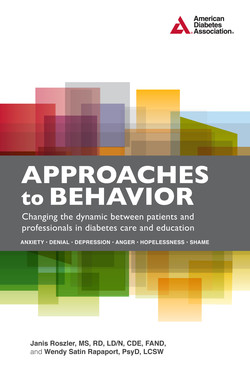Читать книгу Approaches to Behavior - Janis Roszler - Страница 6
На сайте Литреса книга снята с продажи.
ОглавлениеPreface
As a health care professional you have a wealth of knowledge to share. So why don’t some of your patients listen, participate, and follow through?
This book examines the emotional “noise” that makes it more difficult for patients to gain from interactions they have with you, their health care provider. Some of the interference comes from the patients themselves. Living with a chronic disease like diabetes can prompt such feelings as worry, anger, fear, guilt, frustration, and denial that make it harder for patients to learn, collaborate, and make behavioral decisions. Some of the “noise” may also come from you—your mood, energy level, frustration, and even patience level can accompany you in the conversations you have with patients. So, as you read, we not only will focus on your patients’ feelings and emotions, but also will discuss yours as well.
This book focuses on evidence-supported “strength-based” resiliency strategies from family therapy, cognitive–behavioral therapy, emotionally focused therapy, and positive psychology (Norcross, 2002, Hofmann, 2012, Johnson, 2012, Seear, 2013). Many strategies are based on two assumptions: 1) We affect our patients and others in our lives in a bidirectional or circular way—how we feel and act affects how others respond and vice versa; and 2) it is not possible to fully understand another person’s life experience; to gain information about another person, one must respectfully ask questions and not make assumptions.
The guidance we share within this book is not only for those who work with patients who have diabetes. It also is for health care providers who work with individuals who have any challenging medical issue. If you are just beginning your training, read through the entire book first and fill its margins with your personal thoughts. Take a careful look at your own behaviors, both in your work setting and outside of it. Many of the approaches we share can help you communicate more effectively with everyone in your life, not only with your patients and their families but also with loved ones, acquaintances, and colleagues, especially in this era of integrated care. Refer to this book often as you move through your program.
If you are a seasoned health care professional, we invite you to read through the entire book as well. Be introspective and explore the different ways to handle strong emotions you may feel, from time to time, that may be prompted by stresses in today’s health care environment. Use what we share to help you become an even more effective provider, partner, and friend. Many of the approaches may be new to you. We hope that you find them invigorating and effective. We use them ourselves and know how transformative they can be.
The DAWN2 (Diabetes Attitudes Wishes and Needs) study showed that “support which focuses on both clinical and the psychosocial needs of people with diabetes and their families is necessary to ensure successful treatment outcomes” (Novo Nordisk A/S, 2013). The approaches we present in this book can help achieve that goal and can enable you to bring your best self to every personal encounter, at work, and in other areas of your life.
